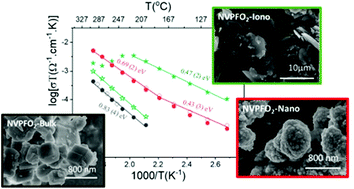Particle nanosizing and coating with an ionic liquid: two routes to improve the transport properties of Na3V2(PO4)2FO2†
Abstract
Na3V2(PO4)2FO2 is a promising candidate for practical use as a positive electrode material in Na-ion batteries thanks to its high voltage and excellent structural stability upon cycling. However, its limited intrinsic transport properties limit its performance at fast charge/discharge rates. In this work, two efficient approaches are presented to optimize the electrical conductivity of the electrode material: particle nanosizing and particle coating with an ionic liquid (IL). The former reveals that particle downsizing from micrometer to nanometer range improves the electronic conductivity by more than two orders of magnitude, which greatly improves the rate capability without affecting the capacity retention. The second approch dealing with an original surface modification by applying an IL coating strongly enhances the ionic mobility and offers new perspectives to improve the energy storage performance by designing the electrode materials’ surface composition.



 Please wait while we load your content...
Please wait while we load your content...